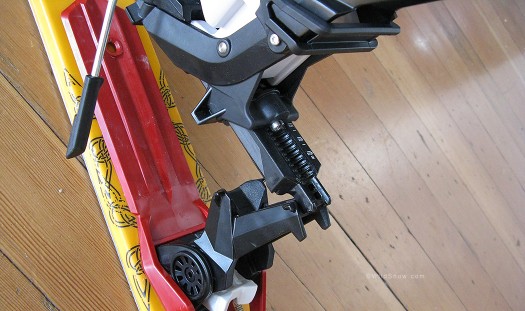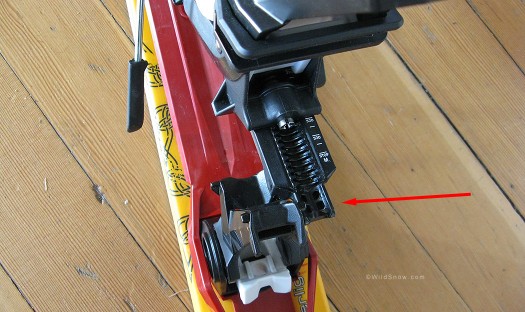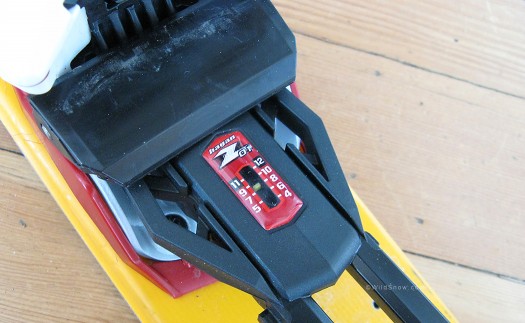The new kid on the block, at least over on this side of the street… First, what are they called? The box says Hagan Z 01 Allmountain. The manual says Hagan Z (presumably referring to both models, the 01 which is built slightly beefier and goes to RV 12, and the Z02 which goes to DIN 10). I guess we’ll call our testers “Z 01.” I’ll bet in speech we’ll be calling them a “Zee-One.” Let me know.
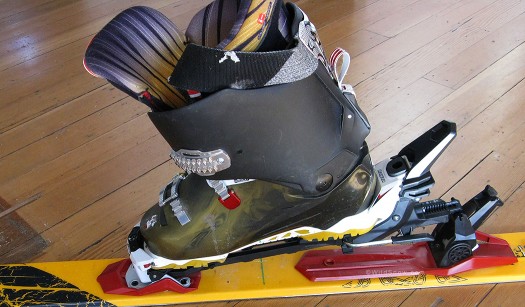
Hagan Z 01 setup I tested. This is a classic 'frame' binding that is step-in step-out, and fits either alpine soled boots or rockered AT boots.
Note that above I write _DIN 10 and _RV 12. That’s because DIN/ISO binding standards 13992 and 9462 don’t go to a release value of 12. Our use of the term “RV” stands for “Release Value.” Excellent that Hagan addresses this in their manual, and even goes so far as to write, “An adjusting range of more than Z 10 is not standardized. The setting in this range is at one’s peril.” Frankly, while the Hagan manual does say the binding is TUV tested and approved to DIN standards, one has to wonder how that can happen when the RV settings go above the standard, invoking the word “peril.” Ah, the mysteries of the TUV bureaucracy.
Be it known that the Hagan grabber is sold in two versions, Z 01 and Z 02. The O1 model backcountry skiing binding is the beefier of the two, appears to be made of better plastic, and yes, sends the beefomatic message by going to RV 12, while the 02 only goes to a wimpomatic 10 and has no brakes (it’s sold with a safety strap, though it does accept same brakes as those sold with 01). The 02 looks to be around a C-note less coin, and is perhaps slightly lighter (though without brake, apples-to-apples weight comparo is a bit meaningless). Due to how the North American market tends to respond to AT ski bindings, we’ll concentrate on the 01. Smaller, less aggressive skiers looking for a budget rig might look at the 02.

Hagan Z 02 backcountry skiing binding is of significantly different color scheme and has a minimal base plate at the rear.
The O1 brakes come in 90, 100, and 115 widths and are compatible with both model bindings.
I mounted the Z 01 without a template or jig (relatively easy, but get a jig mount if you buy a set). Testing commenced on the bench, and on some of our early season snow around here. Due to the double frame bars, wide footprint and tight lock-down, Z 01 backcountry skiing binding is of average stability in downhill mode rolling flex (slop), and compares favorably with other frame bindings in this weight class. Unfortunately, in touring mode Z 01 suffers from the torque and slop problems endemic to frame bindings, and you can easily end up with the back end of the binding plate falling off the high heel lifter while traversing or otherwise maneuvering. Frame bindings can eliminate this problem by beefing their frame rails and toe unit base, but doing so adds weight.
The 01 heel lock and lifter mechanism is impressively easy to operate. Four lift heights are available. The lifter levers up with your pole to the lowest position and two higher positions. Press back down lock for alpine mode or use second to lowest position. I found the process to be intuitive and in no need of lengthy explanation or instruction.
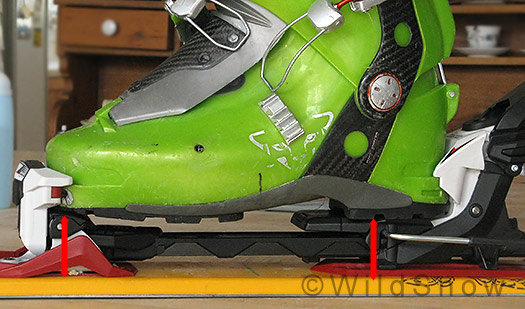
Hagan Z 01 stack height and ramp angle. Binding toe AFD highest point about 45 mm from ski top, heel about 42, for a ramp angle that will fall somewhere from neutral to 3 mm lower at the heel, depending on exact configuration of boot sole (rocker, no rocker, wear, no wear).
01 ramp angle (relation of boot toe height to heel) is a bit in the negative zone, or perhaps close to neutral with some boot toe wear or a rockered ski touring boot. Skiers coming from ramp neutral or heel raised bindings may have to adjust their timing and body position to compensate. Shimming the stack height of this binding to neutral ramp would be difficult and weight intensive, as doing so would require a long, 3 or 4 mm thick shim under the heel mount plate. Better, in the case you do end up with negative delta, to add some forward cuff lean or heel lift to your boots and get used to it. It’s not much, at most 3 mm.
Regarding ramp, to be fair I should also mention that new boots (both alpine and touring) have a small bevel on the bottom of the sole at the toe. This will drop the boot down a few millimeters, and continues to do so as the sole wears from walking. Thus, perhaps it would be more accurate to say that, on average, we are talking a very slight negative ramp for these bindings, or that they’re neutral in terms of delta-ramp.
Informal release testing indicated a smooth torsional and vertical ejection. Effective anti-friction rollers in the toe wings help, as does a basic but functional AFD under the boot toe area. Toe wing height adjustment appears to have adequate range for everything from alpine boots to worn AT boots.
Both model Hagan bindings come in three lengths/sizes which cover a super wide range of boot lengths (255-370mm, with the smaller limit being 5mm less than another leading binding, take note for kids or tiny footed adults). Not only is a selection of frame sizes nice if you’re at the extreme ends of the spectrum, but it allows picking a binding length with less extension of the frame behind your boot heel, thus yielding a bit more rolling flex stability in alpine mode and perhaps preventing some of flex and slippage off the high lift as noted above.
The O2 is said to be strong. I gave them my informal kneeling fall test which has blown up other test bindings over the years (and recently), and all the Hagan did was flex. Impressive, as the pesky problem of knee fall damage has been a plague for years and affected various bindings which were otherwise plenty strong.
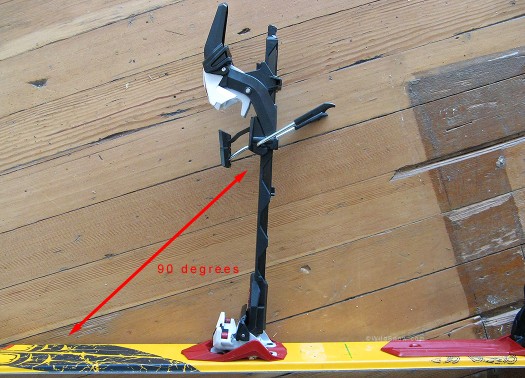
Some bindings may allow more forward stride angle range than the Hagan, but in my field test I found the Hagan range to be adequate and similar to most other frame bindings. Main concern here is destruction of the binding in a kneeling fall. Due to the flex of this binding's strong plastic, my knee fall testing resulted in no damage; during testing you could see it all flexing, but it didn't break.
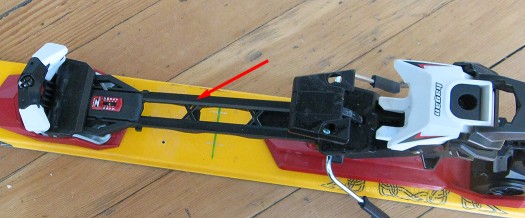
The double Hagan rails, with cross links, are a strong way to build a binding frame. But it's important the plastic used in this area is strong but somewhat flexible to absorb damaging forces such as a kneeling fall while in touring mode. It appears the Hagan frame is made from some sort of carbon reinforced stuff that's super beefy.
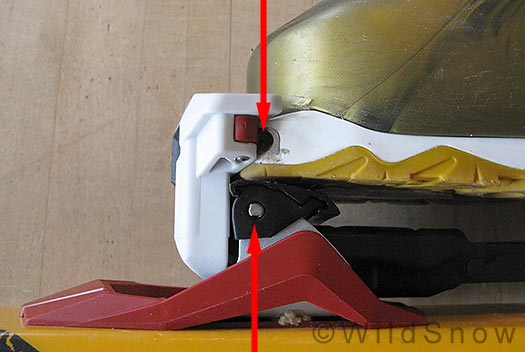
Ah yes, the backcountry skiing binding pivot wars. By virtue of an incredibly low-bulk toe unit, Hagan was able to locate their touring pivot at nearly the same fore-aft position as that of a tech binding, and significantly farther back than some other leading frame bindings. This factor is immaterial for short tours, but important for efficiency if you're going long.
Weight of our Z 01 testers, size medium (BSL 285 – 340) is 36.5 oz, 1034 gr, single binding with brake and screws. This compares favorably with other frame type bindings.
Our take? We see no earth shattering performance advantage to the Hagan Z series bindings over other frame bindings. But they do appear well made for their price point (01 $489.00 MSRP, 02 a hundred less), the weight is okay, and resistance to knee (kneeling) fall damage is acceptable. Our preliminary take, after minimal field testing and no North American consumer consensus as of yet, is this would most certainly be a good binding or the occasional backcountry skier, and might likely be more hardcore than that — though we always wait for extensive use before raving about how prime a binding is.
Indeed, Hagan themselves claim that “The Hagan bindings are particularly aimed at those new to the sport and for those desiring to ski tour for fitness and recreation. They are designed or the large middle ground of recreational skiers intrigued by the ability to get away from crowded ski slopes and develop fitness while skiing. They are not designed or intended for the extremes of randonee racing or highly aggressive free riding.”
While the above might be true, that “large middle ground” is, well, large. So these grabbers could easily be the ticket for a huge population of backcountry skiers.
WildSnow.com publisher emeritus and founder Lou (Louis Dawson) has a 50+ years career in climbing, backcountry skiing and ski mountaineering. He was the first person in history to ski down all 54 Colorado 14,000-foot peaks, has authored numerous books about about backcountry skiing, and has skied from the summit of Denali in Alaska, North America’s highest mountain.

